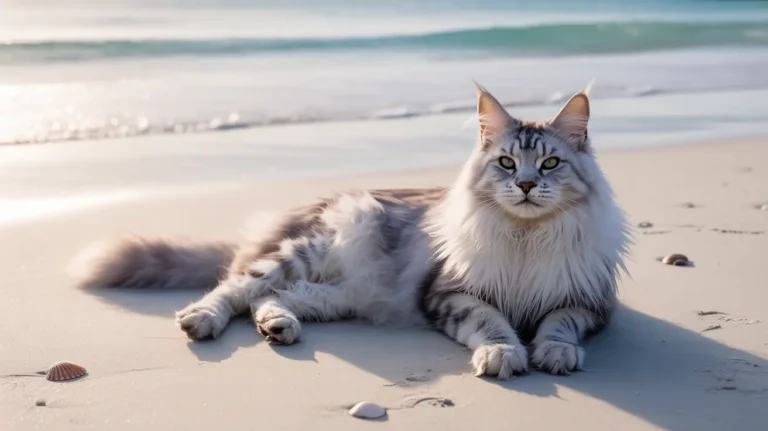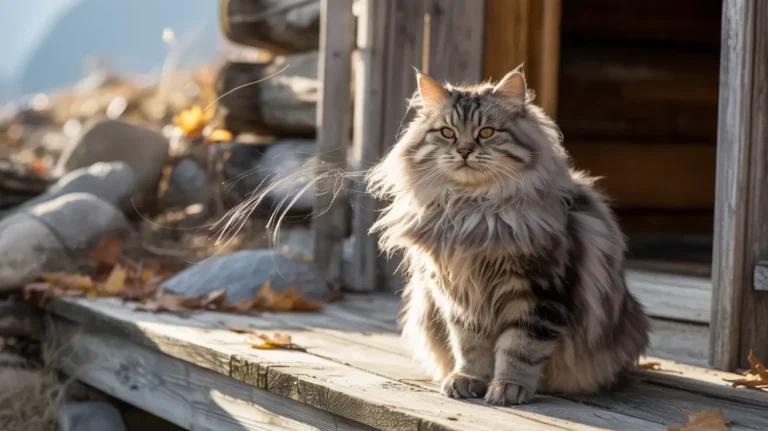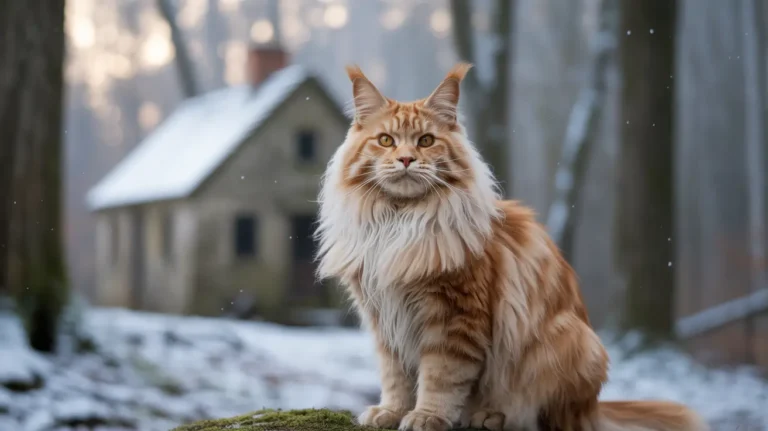Top Maine Coon Cat Training Tips for Smart, Caring Owners
The Maine Coon isn’t just one of the largest domesticated cat breeds—it’s also one of the smartest and most affectionate. These gentle giants have a curious, playful personality that makes them ideal candidates for structured training.
Unlike some cats that resist routine, Maine Coons thrive on interaction and challenges. They enjoy learning new tricks, exploring new spaces, and bonding closely with their human companions.
Their social intelligence and patience make them easier to train compared to many other breeds. Training a Maine Coon goes beyond teaching obedience. It provides mental stimulation, prevents unwanted behaviors, and strengthens the trust between you and your cat.
When done right, training becomes a joyful activity that your Maine Coon genuinely looks forward to . With the right approach and consistency, you can tap into their intelligence and turn training into a rewarding experience for both of you.
Understanding the Maine Coon Mind
Maine Coons are known for their impressive memory and problem-solving abilities. They quickly pick up on household routines and even learn to recognize certain words and cues. Their emotional intelligence also sets them apart—they can sense your mood and respond accordingly.
These cats are naturally observant. They’ll quietly watch you perform tasks and often mimic behavior over time. That’s why consistency and body language play a big role in training.
Avoid loud voices or punishments, as Maine Coons are sensitive and may withdraw if treated harshly. Instead, use positive reinforcement like treats, toys, or affectionate praise. This method not only teaches them desired behaviors but also encourages a healthy, trusting bond.
Understanding how your Maine Coon thinks is the first step toward successful training. When you respect their intelligence and pace, they respond with loyalty and a genuine willingness to learn.
Ready to Start? Here’s How to Use These Maine Coon Cat Training Tips Daily
Training your Maine Coon doesn’t have to feel like a chore—it can become a fun part of your daily routine!
Start by using simple Maine Coon cat training tips throughout the day instead of setting aside long sessions. For example, ask your cat to “sit” before you serve meals or say “come” when it’s treat time. These small, consistent actions help your cat connect commands to real-life situations.
Use your cat’s playtime wisely. Whether it’s with a feather wand or puzzle toy, sneak in cues like “stay” or “leave it” and reward immediately when your cat responds. This keeps training fun, natural, and low-pressure.
If your Maine Coon does something good on their own—like sitting calmly or using a scratching post—praise them! Rewarding these behaviors helps build positive habits without any stress.
The secret is to weave these tips into normal activities. With this approach, your cat learns without even realizing they’re being trained—and you both enjoy the process.
When to Start Training
The best time to begin training a Maine Coon is during kittenhood—between 8 to 10 weeks old. Young kittens are more adaptable and open to learning, which makes this period ideal for establishing good habits.
However, older Maine Coons can also be trained with the right approach. The key is patience, consistency, and positive rewards. Start with short training sessions lasting 5 to 10 minutes.
These cats have a long attention span, but like all pets, they benefit from breaks and playtime in between. Always end training on a positive note so they associate it with something enjoyable.
Remember, the earlier you start, the easier it is to prevent unwanted behavior and encourage mental engagement.
Basic Training Commands
Training your Maine Coon with basic commands isn’t just about teaching tricks—it’s about creating a shared language. Simple cues like “sit” or “come” build trust, boost mental stimulation, and help prevent unwanted behaviors.
Because Maine Coons are smart and eager to please, they respond well when training is consistent, positive, and fun. Start with small steps, use a calm tone, and always reward the behavior you want to encourage.
Essential commands to begin with
Leash and Harness Training
Walking your Maine Coon can be a fun and enriching experience. Begin by letting your cat wear the harness indoors for a few minutes each day. Choose a padded, escape-proof harness designed for large cats.
Once your cat is comfortable wearing the harness, attach a lightweight leash and let them drag it around to get used to the feeling. Gradually guide them around the house.
Only move outdoors when your cat seems fully confident inside. Start with a quiet, enclosed area like a backyard. Avoid noisy streets or unfamiliar animals that might scare them.
Be patient and allow your cat to explore at their own pace. Walking on a leash not only provides exercise but also deepens your connection.
Clicker Training: Engaging Their Brain
Clicker training is a popular method that reinforces good behavior using a small clicking sound. When your Maine Coon performs a desired action, you “click” immediately and follow with a treat.
This technique works because it gives your cat instant feedback. Start with simple tasks like “sit” or “touch.” Every time they do it right, click and treat. Eventually, your cat will link the sound with success.
Keep training sessions short and engaging. If your Maine Coon loses interest, take a break and resume later.
Clicker training is not just effective—it’s also mentally stimulating for your cat. It provides clear communication, boosts confidence, and makes learning feel like a game.
Fun Tricks to Teach Your Maine Coon
Maine Coons love learning tricks, especially when it’s turned into play. Start with simple ones like “high five,” “fetch,” or “spin.” Break each trick into small steps and reward progress.
Use their favorite toy or a tasty treat to keep them motivated. For example, to teach “fetch,” throw a toy and reward them if they bring it back, even partially. Keep your tone upbeat and sessions brief. Celebrate every success, no matter how small.
These tricks provide mental enrichment and help burn off excess energy. Plus, they’re a fun way to show off your cat’s talents!
Dealing with Stubbornness or Boredom
Even the smartest cats have off days. If your Maine Coon ignores commands or walks away, they may be tired or bored. Don’t push them. Take a break and try again later with a new toy or different treat. Keep training fresh by changing the setting or mixing in new activities.
Maine Coons are independent thinkers. The trick is to work with their mood, not against it. When you stay flexible and positive, they’ll eventually come around.
Using Play as a Training Tool
Training doesn’t always require formal sessions. You can teach your Maine Coon through everyday play. Try saying “sit” before tossing a toy or “stay” before opening a door. Games like feather wands or puzzle toys can help with focus and patience.
Use these moments to reinforce good behavior. End playtime with a calm activity like brushing or cuddle time to teach balance between excitement and relaxation.
Socialization and Behavior Shaping
Expose your Maine Coon to different people, environments, and experiences early on. This helps them grow into confident, well-behaved cats. Invite friends over, let them hear new sounds, or take them on car rides in a carrier. Always reward calm behavior with treats and praise.
If your cat is fearful or aggressive, don’t force interactions. Go slowly and let them approach in their own time. Positive exposure builds trust. Socializing also makes routine vet visits and travel much easier.
Preventing Bad Habits
Scratching, jumping on counters, or biting can be redirected with the right approach. Provide scratching posts in multiple areas and praise your cat when they use them. For jumping, say “off” and gently guide them down—then reward when they stay off.
Biting during play can be stopped by pausing the game and offering a toy. Avoid rough play with your hands.
Focus on teaching what to do, not just what not to do. Positive reinforcement is the most effective correction tool.
How to Keep Training Fun and Effective
Keep your training varied to maintain interest. Switch up rewards, practice in new rooms, and introduce creative commands. Cats, like humans, get bored with repetition. Use toys one day and treats the next. Try training after play sessions when their energy is balanced.
Always praise effort—even if the result isn’t perfect. Training should be a shared adventure, not a strict routine.
Common Training Mistakes to Avoid
Avoid yelling, punishment, or physical corrections. These scare your cat and break trust. Don’t overwhelm your cat with long or back-to-back training sessions. Keep things short and positive.
Be consistent with commands and rewards. Changing your tone or gestures can confuse your Maine Coon.
With patience and clear guidance, your cat will learn steadily and happily.






